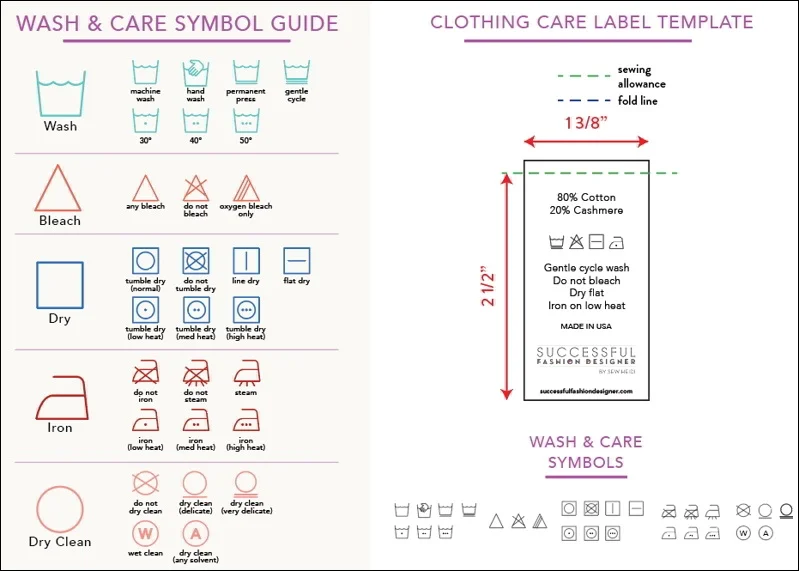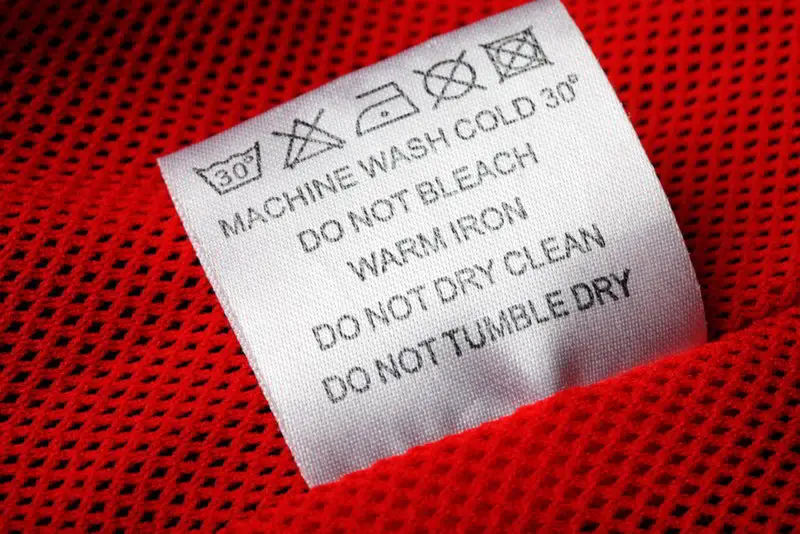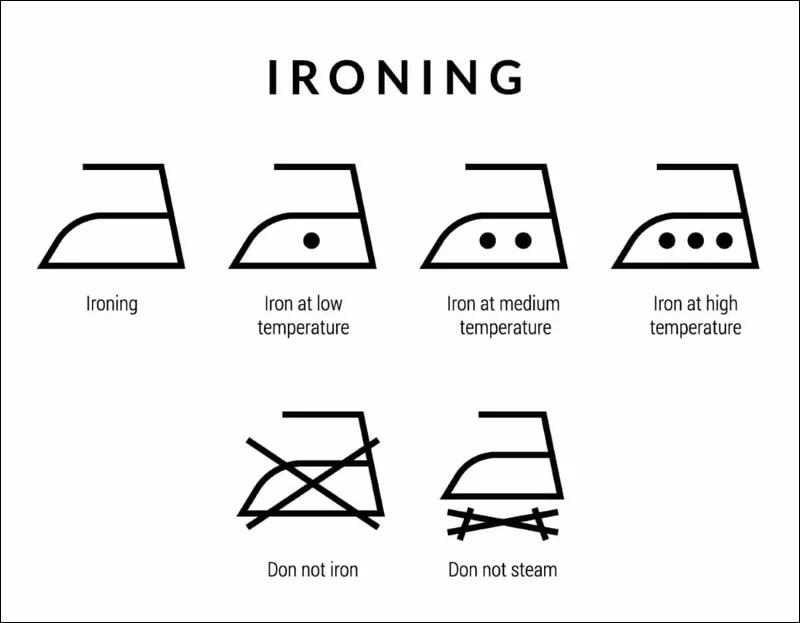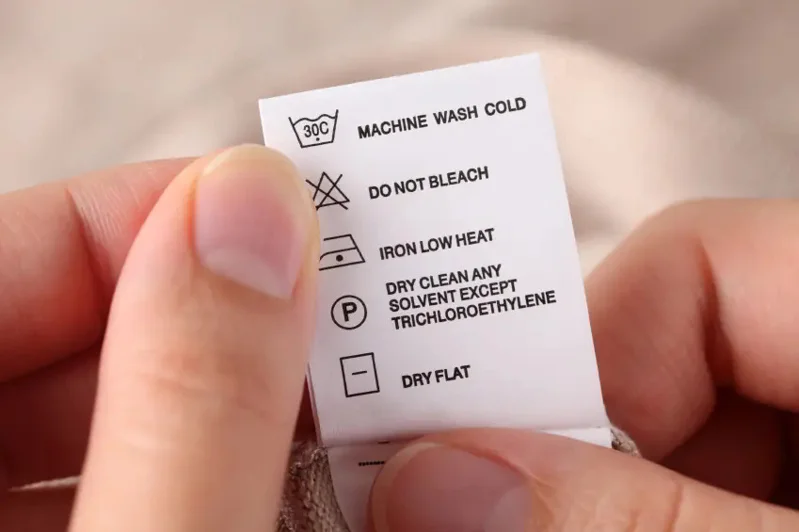Care Instructions: Key to Garment Quality & Brand Trust
Confused about clothing care labels? Wondering what care instructions are and why they’re vital for your apparel business? This guide explains how clear, accurate care labels preserve garment quality, ensure customer satisfaction, build brand trust, and ensure legal compliance (like FTC rules).
Learn to decode the standard symbols (washing, bleaching, drying, ironing, dry cleaning) and understand their modifiers. Discover best practices for determining instructions for different fabrics, choosing durable label materials, and the importance of testing. Investing in clear care instructions is an investment in your product and brand success.
1. Defining care instructions: More than just a garment label
1.1 The essential product information on a clothing tag
A care label is a permanently affixed garment label or clothing tag that provides specific guidance for maintaining a garment. This crucial piece of product information typically details instructions across several categories: washing, bleaching, drying, ironing, and professional dry cleaning (often referred to generally as textile care). While often included on the same tag, fabric content (the materials used, like cotton or polyester) and country of origin are distinct pieces of information, though related to the garment’s overall profile. The primary purpose of the care label is straightforward: it instructs on garment care to help the owner clean the item properly, preventing damage and preserving its quality over time.

1.2 Why care labels exist: Protective measures and informing consumers
Care labels serve a dual function critical for both the garment and the consumer. Primarily, they act as a protective measure for the garment itself. Following the provided instructions helps prevent damage like shrinking, stretching, color loss, or fabric degradation, thereby extending the garment lifespan.
Secondly, these labels are fundamentally informational, clearly communicating the required method for proper textile care. This manages consumer expectations about the effort involved in maintaining the garment and prevents dissatisfaction arising from accidental damage caused by incorrect cleaning methods.
In many regions, including the US, legal requirements also mandate the presence of accurate care labels, further underscoring their necessity.
2. The critical role of care instructions for your clothing business
2.1 Preserving garment quality and ensuring customer satisfaction
Accurate care instructions are fundamental to maintaining garment quality. When customers follow the recommended care, the fabric’s integrity, color vibrancy, shape, and texture are preserved for much longer. This directly translates to higher customer satisfaction.
A customer whose garment withstands wear and washing well, avoiding issues like shrinking or significant color fading, is far more likely to feel positive about their purchase, leading to repeat business and positive word-of-mouth.
Conversely, unclear or incorrect instructions can lead to damaged clothing, customer frustration, and negative brand perception. Proper care advice preserves fabric integrity and contributes significantly to garment longevity.
2.2 Building brand reputation and minimizing costly mistakes
Providing clear, accurate labels signals professionalism and attention to detail, which are key components in building brand reputation. Customers perceive brands that offer reliable care information as more trustworthy and quality-focused. Furthermore, effective care instructions proactively minimize costly mistakes for the business.
They reduce the volume of customer service inquiries related to garment care, decrease the likelihood of complaints due to damage from improper washing, and ultimately lower the costs associated with returns, exchanges, or refunds – enhancing overall customer satisfaction indirectly through problem avoidance.

2.3 Complying with regulations: The FTC care labeling rule (US focus)
For businesses selling textile garments in the United States, compliance with the Federal Trade Commission (FTC) care labeling rule is mandatory in the US. This regulation stipulates that most apparel requires care labels providing complete and accurate textile care instructions.
Key requirements for legal compliance include: the label must be permanently attached and accessible, remain legible throughout the useful life of the garment, provide instructions for all necessary regular care procedures (like washing, drying, ironing, bleaching, dry cleaning), and include warnings if any standard care procedure would harm the item. These instructions must be based on reasonable testing evidence. Failure to comply can result in significant penalties, including fines and legal action.
2.4 Guiding consumer choices and proper garment maintenance
Care labels play a significant role in consumer education even before a purchase is made. A customer might check the label to see if a garment requires expensive or inconvenient care (like “dry clean only”) and choose accordingly. Post-purchase, the label becomes the primary guide for ongoing garment maintenance.
Clear instructions empower consumers, giving them the confidence and knowledge to care for their clothing correctly. By simplifying the process of reading labels, businesses help ensure their products are maintained properly, reflecting well on the garment’s inherent quality and durability, thus empowering consumers in their clothing care routines.
3. Decoding the symbols: A practical guide to care label language
3.1 Understanding the 5 basic care symbols: Wash, bleach, dry, iron, dry clean
The language of textile care often relies on standardized symbols, a form of pictogram-based communication designed for universal understanding. There are five primary care symbol categories, largely standardized internationally through organizations like GINETEX (the International Association for Textile Care Labelling).
These categories are represented by distinct shapes: the washing tub symbol for washing, the triangle symbol for bleaching instructions, the square symbol for drying methods, the iron symbol for ironing guidance, and the circle symbol for professional cleaning requirements. Understanding these five basic laundry symbols is the first step to correctly interpreting a care label.
3.2 Washing instructions: Temperature, cycles, and hand washing
The washing symbol, shaped like a tub of water, details the appropriate washing method. A number inside the tub indicates the max temperature in Celsius that should be used. For example, ’30’ means wash at or below 30°C. Some older labels might use dots (one dot for cold, increasing dots for warmer temps), though this is less common now.
A tub with a hand depicts the hand wash symbol, recommending gentle washing by hand or a machine’s hand-wash cycle, typically at 40°C or below. Bars underneath the tub symbol (explained further later) indicate the required gentleness of the washing cycle regarding spin and agitation.
3.3 Bleaching guidance: When and what type to use (or avoid)
The triangle symbol provides crucial bleaching rules. An empty, outlined triangle signifies bleaching allowance, meaning any type of bleach (chlorine or oxygen-based) can be used when needed. A triangle with two diagonal lines inside indicates that only non-chlorine bleach (oxygen-based) should be used; chlorine bleach will likely damage the fabric or color.
A solid black triangle with a large ‘X’ through it means do not bleach – using any type of bleach risks harming the garment. Adhering to these symbols is vital for maintaining the color and integrity of the fabric.
3.4 Drying methods: Tumble drying settings and natural techniques
The square symbol covers various drying methods. A circle inside the square specifically refers to tumble drying. Dots inside this circle indicate heat settings: one dot for low heat, two for medium, and three for high. A square with a circle and a large ‘X’ through both means do not tumble dry.
The square symbol also depicts natural drying techniques: a single horizontal line inside means ‘dry flat’; a curved line hanging from the top means line drying (hang to dry); three vertical lines mean ‘drip dry’ (hang wet, no wringing); and diagonal lines in the top left corner signify ‘dry in shade’ to prevent fading. Understanding the correct drying symbol prevents shrinking or heat damage from tumble drying when inappropriate.
3.5 Ironing temperatures: Matching heat to fabric needs
The iron symbol indicates whether and how a garment should be ironed. Dots inside the iron specify the maximum heat setting: one dot represents low heat iron (around 110°C), suitable for delicate fabrics like silk, wool, and some synthetics; two dots mean medium heat (around 150°C), often used for polyester and other synthetics; three dots indicate high heat (around 200°C), appropriate for linen and cotton.
An iron symbol with a large ‘X’ through it means do not iron. Additionally, an iron symbol with crossed-out lines emanating from the bottom signifies “do not use steam.” Following these ironing settings prevents scorching or melting fabrics.

3.6 Professional dry cleaning: Understanding the circle and letters
The circle symbol indicates that the garment requires professional dry clean services. A plain circle generally means the item can be dry cleaned. Letters inside the circle (commonly ‘P’, ‘F’, or sometimes ‘A’ or ‘W’ for specialized processes) provide instructions for the dry cleaner on solvent type or cleaning method.
‘P’ usually stands for Perchloroethylene solvent, while ‘F’ indicates Flammable (hydrocarbon) solvents. An ‘X’ through the circle means do not dry clean. For the business owner and consumer, the primary message of the circle symbol is that the item should not be washed at home but taken to a professional cleaner.
3.7 Interpreting modifiers: The meaning of bars and crosses (X)
Beyond the basic shapes, two key modifiers add detail to care instructions. A large cross symbol placed over any of the five main symbols universally means do not perform the action indicated by that symbol (e.g., do not wash, do not iron). A bar placed beneath a symbol, primarily the wash tub or dry clean circle, indicates the required cycle gentleness.
One bar signifies that a gentle cycle is needed (e.g., reduced spin speed, milder agitation). Two bars mean a very gentle cycle is needed, requiring minimal agitation and spin, typically used for very delicate items. These modifiers refine the care instructions for optimal garment protection.
4. Practical considerations for small clothing businesses
4.1 Determining appropriate care instructions for different textiles
Selecting the correct care instructions starts with understanding the fabric care needs based on material composition. Businesses must conduct textile care testing or rely on accurate information from fabric suppliers. For common materials like cotton, higher wash temperatures and tumble drying might be acceptable.
Polyester often requires lower temperatures. Delicate fabrics such as silk and wool typically need hand washing or very gentle cycles and specific drying methods. For blended fabrics, the care label must reflect the needs of the most sensitive fiber present in the garment, including linings, trims, or decorative elements. The care method chosen for a specific fabric type must be safe for the entire product.
| Fabric Type | Typical Washing | Typical Drying | Typical Ironing | Notes |
|---|---|---|---|---|
| Cotton (100%) | Warm/Hot (check color) | Tumble Dry Medium/High | High Heat | Check for shrinkage potential |
| Polyester (100%) | Cool/Warm | Tumble Dry Low | Low/Medium Heat | Can pill; avoid high heat |
| Silk | Hand Wash Cold/Dry Clean | Line Dry/Dry Flat | Low Heat (No Steam) | Very delicate; avoid bleach |
| Wool | Hand Wash Cold/Dry Clean | Dry Flat | Low Heat (Steam OK) | Prone to shrinking/felting |
| Linen | Cool/Warm | Line Dry/Tumble Low | High Heat (Damp) | Wrinkles easily |
| Rayon/Viscose | Cool Gentle/Hand Wash | Line Dry/Dry Flat | Low Heat | Weak when wet; may shrink |
| Spandex Blends | Cool/Warm | Tumble Dry Low/Line Dry | Low Heat | Avoid high heat & chlorine bleach |
Disclaimer: Always test specific fabrics before finalizing labels.
4.2 Best practices for label material, durability, and placement
The physical care label itself requires careful consideration. Materials vary, including woven labels (durable, premium feel), printed satin (smooth, good detail), or Tyvek (strong, paper-like). The chosen material must be durable enough to last the expected lifespan of the garment and remain legible.
Font size and symbol clarity are crucial. Placement must be consistent and comply with regulations like the FTC Care Labeling Rule, which generally requires labels to be easily found by the consumer (often in a side seam or neck area).
Tagless options, applied via heat transfer, offer comfort but must also meet durability requirements. For items sold in the US, including the Registered Identification Number (RN Number) assigned by the FTC is also a common practice and part of the manufacturer responsibility.

4.3 Testing your instructions: Ensuring accuracy before production
Before finalizing the care label and commencing large-scale production, thorough testing of the proposed instructions on the actual garment or representative fabric samples is essential. This verification step ensures the specificity to garment aftercare recommendations are effective and do not cause unexpected damage like color bleeding, shrinking, or distortion.
Performing these tests provides the “reasonable basis” required by the FTC Care Labeling Rule to support the care instructions provided. Skipping this critical step risks producing garments with incorrect labels, potentially leading to widespread customer issues and liability. Ensuring accurate labels through testing protects both the customer and the business.
4.4 The value of educating customers on proper garment care
Beyond the mandatory label, businesses can enhance customer satisfaction through further customer education on garment care. Providing additional information on hang tags, product pages on the website, or even in order confirmation emails reinforces proper maintenance.
Explaining why certain care steps are necessary (e.g., “wash cold to preserve color vibrancy”) adds value. Clarifying the meaning behind the symbols empowers consumers to avoid costly mistakes. This proactive approach can reduce misuse, minimize returns due to accidental damage, and position the brand as helpful and invested in the longevity of its products.
5. Related questions
5.1 Are care labels legally required on all clothing sold in the US?
Generally, yes. The FTC care labeling rule mandates that most textile apparel sold in the US must have permanently attached care labels with clear instructions. However, there are specific exceptions outlined by the FTC.
These include items that are fully reversible without pockets, certain items where a label would impair the appearance or usefulness (like hosiery), products intended for one-time use (disposable items), textile items sold to institutional buyers for commercial use (like uniforms not purchased by employees), and non-textile items like shoes, gloves, and hats.
Despite these exceptions, if there’s any doubt about whether an item falls under the rule, providing a label that ensures legal compliance is the safest approach and generally expected by consumers. Meeting the requirement requires care labels for the vast majority of clothing products.
5.2 What happens if my care labels are inaccurate or missing?
Providing inaccurate or missing care labels can lead to several negative consequences. The FTC care labeling rule allows the agency to take enforcement actions, which can include official warnings or substantial civil penalties assessed per violation (potentially per mislabeled garment).
Beyond direct FTC action, inaccurate labels damage brand reputation, leading to increased customer complaints, negative reviews, and costly returns or demands for refunds when garments are damaged due to following faulty instructions. In some cases, businesses might be required to undertake corrective actions, such as notifying past purchasers about the correct care procedures.
5.3 Should I use internationally recognized symbols (like GINETEX) for my brand?
Using internationally recognized standardized symbols, such as those developed by GINETEX (International Association for Textile Care Labelling) and often incorporated into ISO standards, is highly recommended. While the US FTC Care Labeling Rule allows for text-only instructions provided they are clear, symbols offer significant advantages, especially for brands with international sales or diverse customer bases. These symbols provide near-universal understanding across language barriers, enhancing clarity and reducing the chance of misinterpretation. Employing these symbols signals a commitment to clear communication and international recognition, making labels more user-friendly globally.
5.4 Can I create custom care instructions, or must I use standard symbols?
The core requirement under the US FTC Care Labeling Rule is that care instructions must be accurate labels providing clear instructions based on reasonable testing. This means text-based instructions are permissible if they meet these criteria. Standardized symbols are considered best practice because they offer established clarity and broad recognition.
While you can supplement standard symbols with text or, in theory, use only very clear text, creating entirely custom symbols is generally discouraged. Non-standard symbols risk being ambiguous or confusing to consumers, potentially leading to garment damage and failing the “clear instructions” requirement.
Relying on widely understood, standard symbols is the safest and most effective approach for compliance and customer understanding.
Read more:
Care instructions are far more than a regulatory hurdle; they are an integral part of the product experience. Providing clear, accurate, and easily understandable care information is vital for preserving garment longevity, ensuring customer satisfaction, building brand trust, and maintaining legal compliance. Understanding the standard symbols and diligently determining and testing the correct procedures for each garment are crucial steps.
Businesses should view the creation and application of accurate labels not merely as a cost but as an investment in their product’s quality perception and their relationship with customers. Embracing clarity in care communication contributes significantly to long-term success. For expert guidance on label solutions tailored to your brand, exploring resources from experienced suppliers can provide valuable support.






















